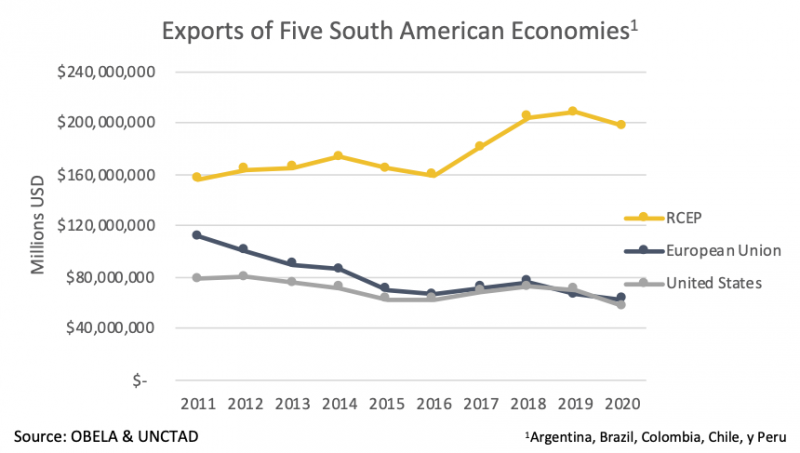Latin America in the complexity of transpacific multilateralism
- blog de bacosta
- 3912 lecturas
Latin America's trade with the Indo-Pacific region has become more dynamic in the last decade. It occurred by the emergence of China as an economic power and by the efforts of Latin American integration mechanisms. During this period, LAC exports to the European Union decreased, and those to the United States slowed down. For Latin American and Caribbean countries, the shift from the centre of the world economy to the Pacific basin means the opportunity to decrease their historical dependence on the West and the North Atlantic.
Regionalism in the Indo-Pacific is limited to commercial interests. China is leading in this process with its Belt and Road Initiative. A significant element of this is the creation of the Regional Comprehensive Economic Partnership (RCEP); with 30 per cent of the world's GDP, the RCEP countries represent an alternative for Latin America.
In its various forms, Latin American regionalism has become a way to connect with other regions. The Pacific Alliance (PA), made up of Chile, Colombia, Mexico and Peru, is committed to free trade in the neoliberal logic; therefore, its external links are in those terms. As for its relationship with Asia-Pacific, this mechanism has a cooperation agreement with the Association of Southeast Asian Nations (ASEAN) and a Free Trade Agreement with Singapore.
The Community of Latin American and Caribbean States (CELAC) is mainly a space for political coordination; however, in terms of economic cooperation, the CELAC-China Forum stands out. The forum discussed not using the dollar for trade transactions. CELAC has had rapprochements with India, Japan and ASEAN, but the relationship is still not very significant.
Central America and the Caribbean have few links with Asia-Pacific. In the Central American Integration System (SICA), South Korea, India, Japan, and Taiwan are development partners. Some countries in this sub-region still recognize Taiwan as an independent state. As a result, the relationship with Beijing had not been close; however, this has changed due to Central America's interest in attracting infrastructure and technology funding from the People's Republic of China.
South America is the bastion of Chinese trade and investment; it is also the sub-region most economically connected to Asia-Pacific. MERCOSUR has a Preferential Trade Agreement with India; Peru and Chile are part of the PA and the Trans-Pacific Partnership (TPP11). Brazil, the region's largest economy, is part of the BRICS Group, which implies close trade links with China, India and Russia.
The leading destination for Latin American exports is Asia-Pacific. This trend has existed in the last decade (2011-2020) in five of the six most significant Latin American economies (Argentina, Brazil, Chile, Colombia, and Peru). Unlike its South American peers, Mexico's largest trading partner is still the United States.
Exports from South America's five largest economies to RCEP countries far exceed those to the United States and the European Union. Between 2011 and 2019, exports to RCEP countries grew by 24% for Argentina, 28% for Brazil, 90% for Colombia, 60% for Peru and 2% for Chile. In the same period, exports to the United States decreased by 2% for Brazil, 6% for Peru and 38% for Colombia; Argentina and Chile recorded growth (8% and 14%, respectively).

The case of Mexico is slightly different from that of South America. The United States is its leading trading partner; the second is the RCEP bloc. Exports to Asia-Pacific have surpassed trade with the European Union. Mexican exports have increased, between 2011 and 2019, by 61% to the RCEP, 36% to the US and 34% to the EU.

The United States undermines Trans-Pacific multilateralism in a reluctant attempt to retain its hegemony. The QUAD Group (Australia, Japan, India, and the US) is another project aligned with US geopolitical interests. The Indo-Pacific Prosperity Economic Framework (IPEF) is Joe Biden's initiative to regain regional influence. The IPEF seeks to compete with the RCEP; however, Southeast Asian countries find better economic and trade opportunities with China. Washington's interest in the Indo-Pacific is to contain China, not business or integration.
While China is beginning to lead on the side of economic persuasion, the US opts for political and military coercion. The North-West Atlantic axis is locked in an anachronistic narrative; at the same time, Asia-Pacific is betting on economic pragmatism. For Latin America, this scenario is favourable for the diversification of its exports, attracting investment in infrastructure, technology and sources of financing from Beijing.
Download / Español